How Much Electricity Sharing Will Electric Vehicle Owners Allow from Their Battery? Incorporating Vehicle-to-Grid Technology and Electricity Generation Mix
Abstract
1. Introduction
2. Literature Review
3. Methodology and Data
3.1. Mixed MDCEV Model
3.2. Choice Experiment and Data
4. Results and Analysis
4.1. MDCEV Estimation Results
4.2. Scenario Analysis for the Electric Vehicle Market
4.3. Policy Implications
4.4. Limitations
5. Conclusions
Author Contributions
Funding
Conflicts of Interest
Nomenclature
| EV | Electric vehicle |
| V2G | Vehicle to vehicle |
| ESS | Energy storage system |
| ICEV | Internal combustion engine vehicle |
| EVSE | Electric vehicle supply equipment |
| BEV | Battery electric vehicle |
| FCEV | Fuel cell electric vehicle |
| PHEV | Plug-in hybrid electric vehicle |
| MDCEV | Multiple discrete-continuous extreme value |
| AFV | Alternative fuel vehicle |
| RUM | Random utility theory |
| Number of alternatives in an alternative set | |
| Baseline utility | |
| Attribute of th alternative | |
| Translation parameter | |
| Satiation parameter | |
| Usage of th alternative | |
| Total amount of usage | |
| Mileage for each household | |
| Mileage of the present passenger’s car usage of the household |
Appendix A
Supplementary Information for EVs
| Manufacturer | Model | Battery Capacity (kWh) |
|---|---|---|
| Tesla | Model X (performance) | 100.0 |
| Model X (long range) | 100.0 | |
| Model S (performance) | 100.0 | |
| Model S (long range) | 100.0 | |
| Model 3 (performance) | 75.0 | |
| Model 3 (long range) | 75.0 | |
| Model 3 (standard) | 50.0 | |
| Jaguar | I-face | 90.0 |
| Mercedes-Benz | EQC | 80.0 |
| Hyundai | Kona (standard) | 64.0 |
| Kona (economic) | 39.2 | |
| Ionic | 38.3 | |
| Kia | Niro (standard) | 64.0 |
| Niro (economic) | 39.2 | |
| Soul (standard) | 64.0 | |
| Soul (economic) | 39.2 | |
| Chevrolet | Volt EV | 60.0 |
| Nissan | Leaf | 40.0 |
| BMW | i3 120Ah | 37.9 |
| Renault Samsung | SM3 Z.E. | 35.9 |
Appendix B
Supplementary Information for Scenario Analysis
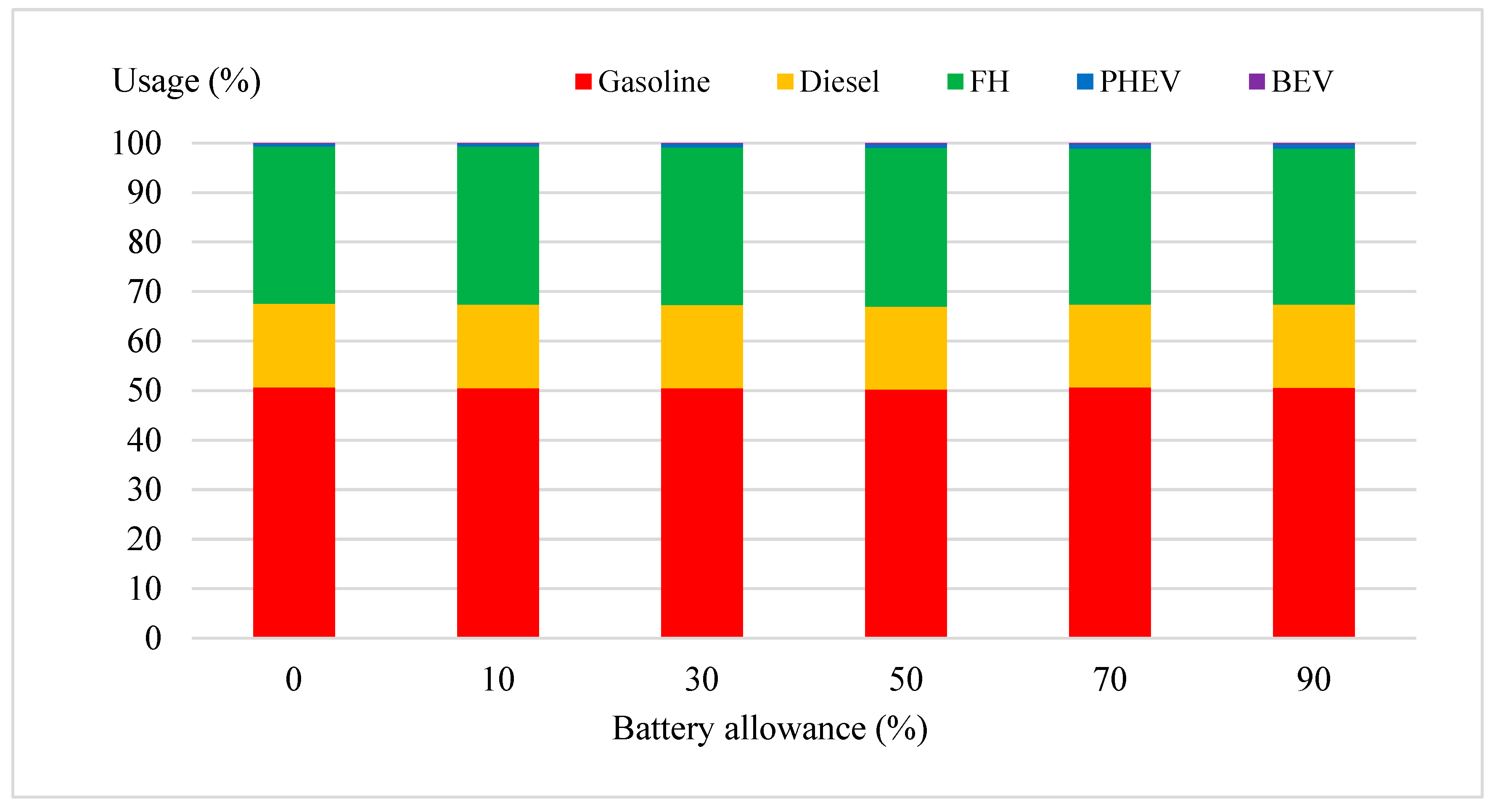
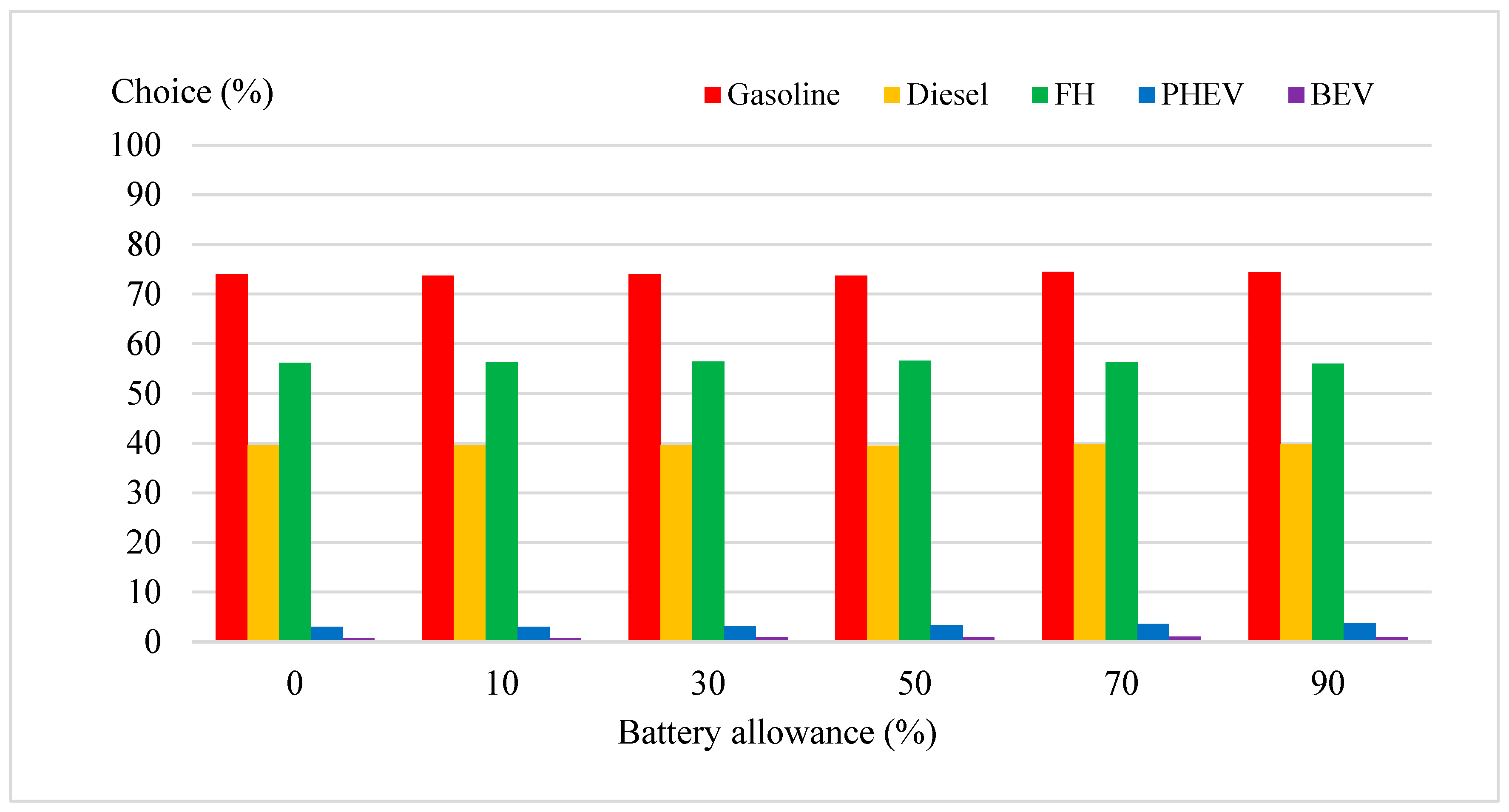
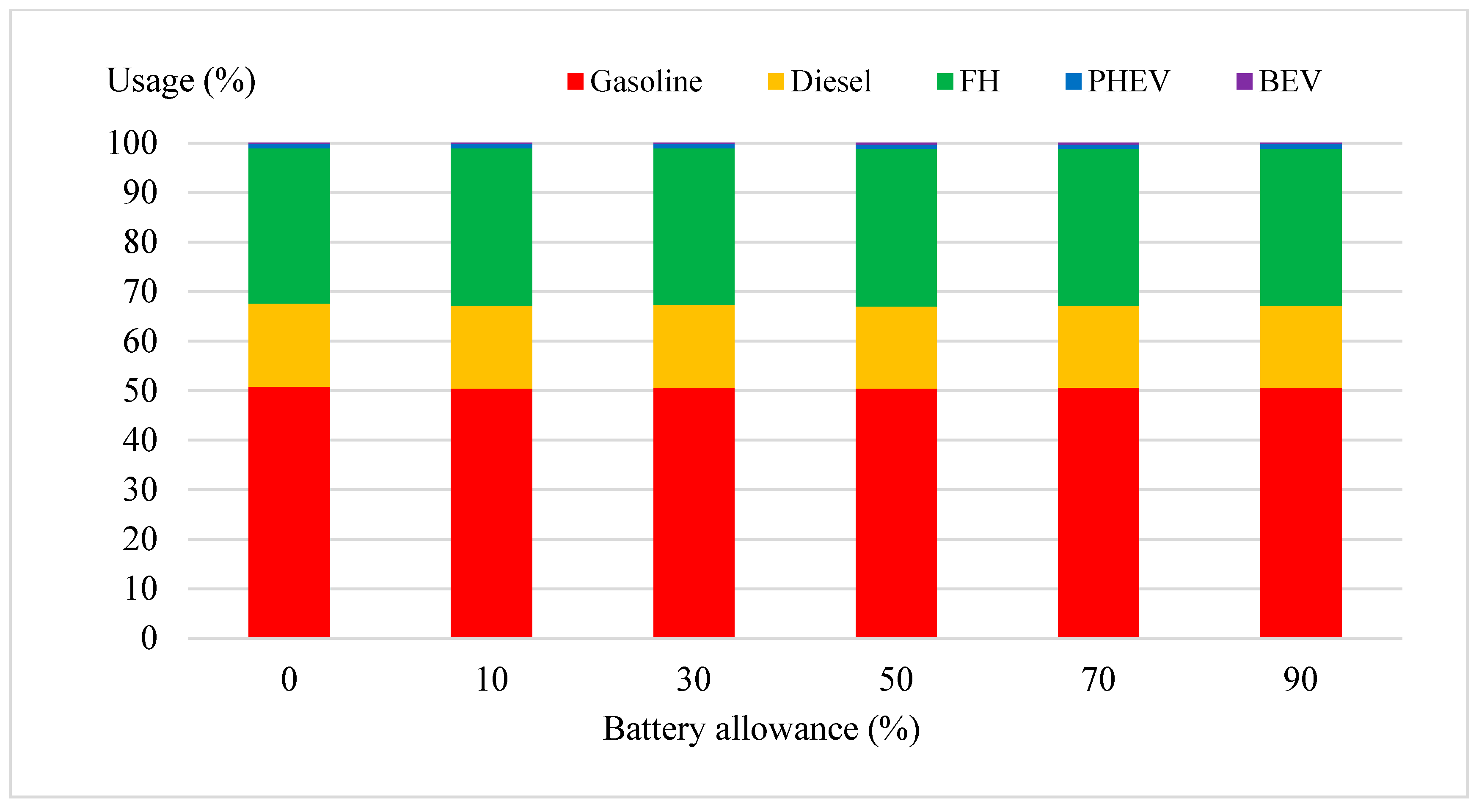
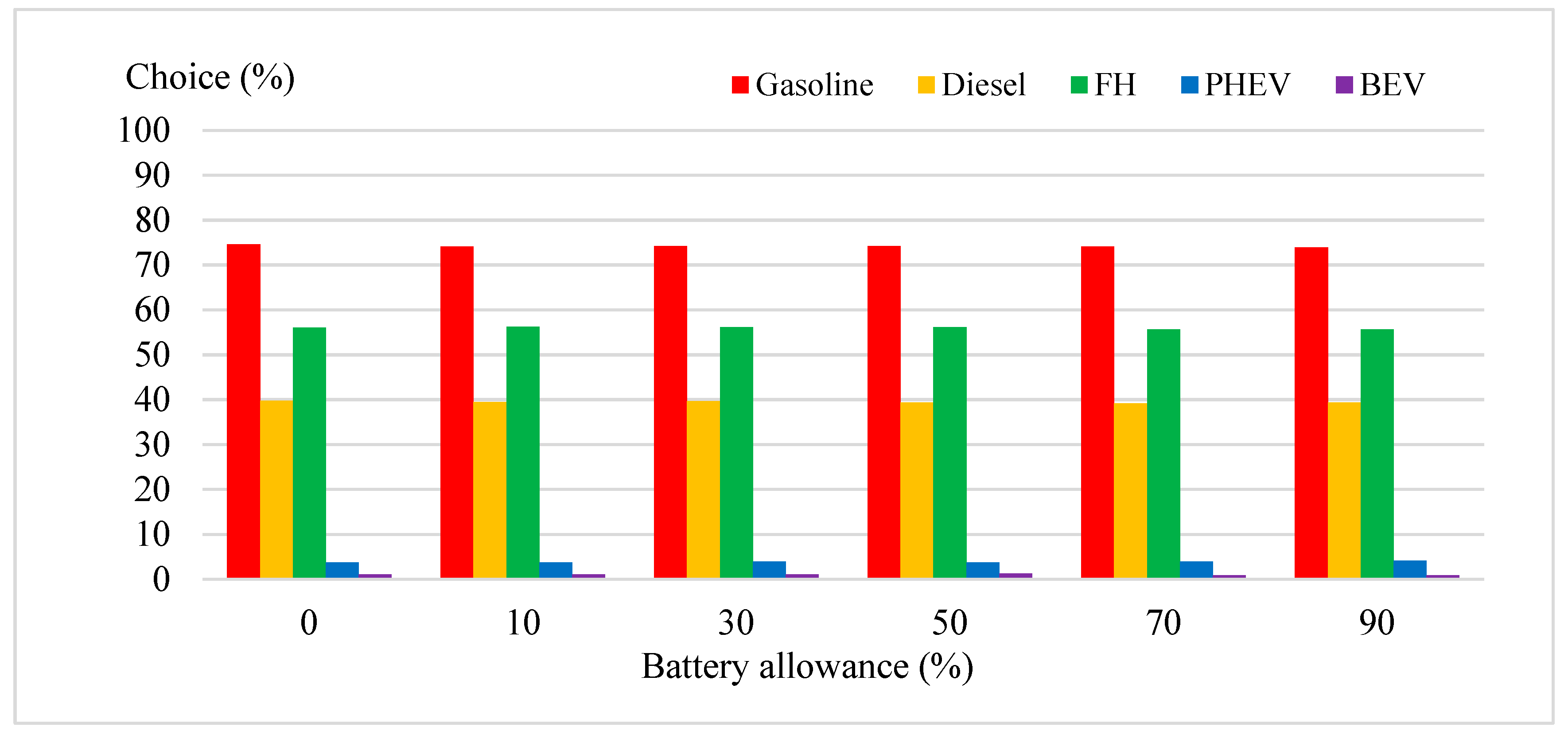
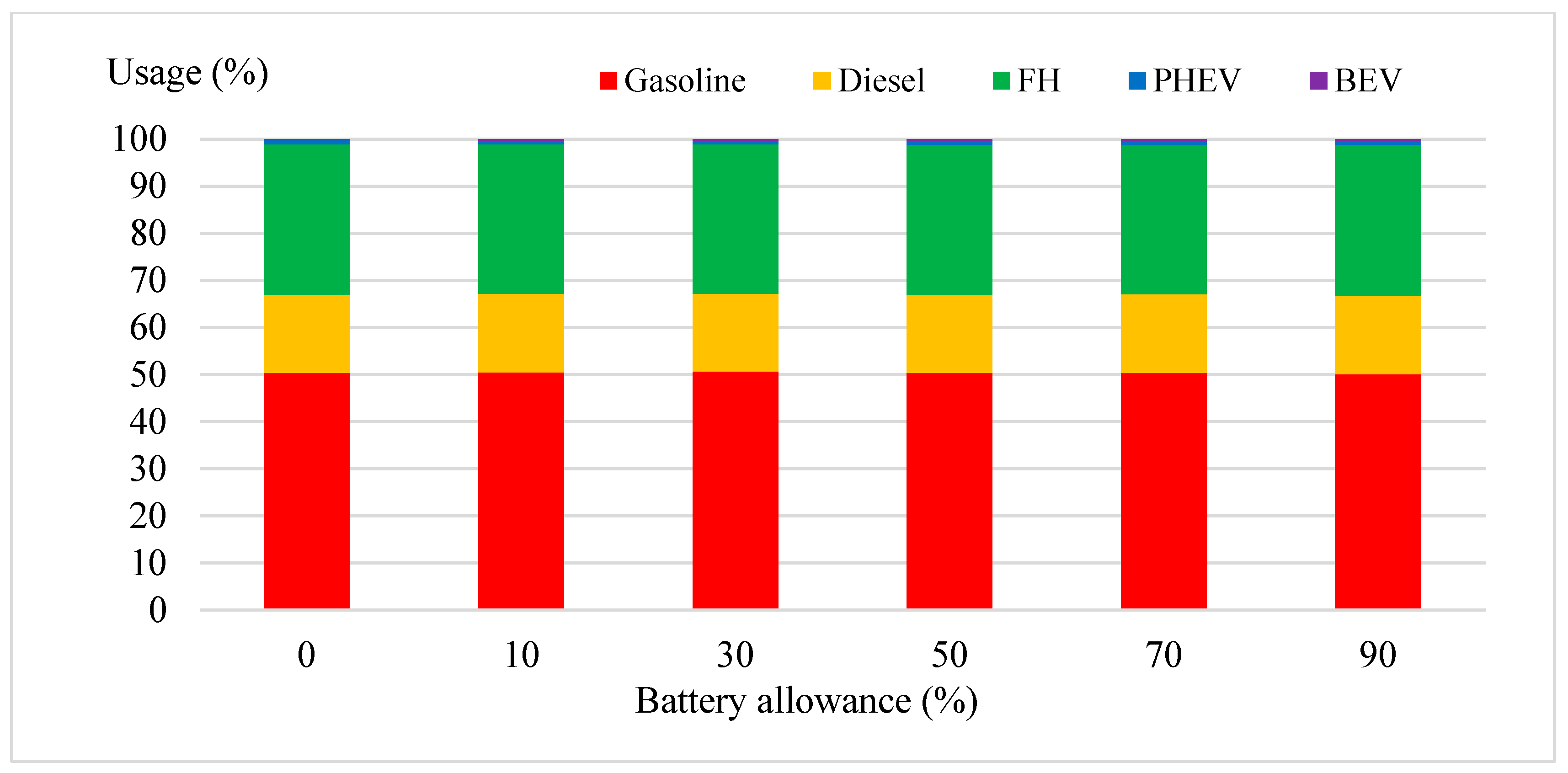

References
- Ibrahim, H.; Ilinca, A.; Perron, J. Energy storage systems—Characteristics and comparisons. Renew. Sustain. Energy Rev. 2008, 12, 1221–1250. [Google Scholar] [CrossRef]
- Hadjipaschalis, I.; Poullikkas, A.; Efthimiou, V. Overview of current and future energy storage technologies for electric power applications. Renew. Sustain. Energy Rev. 2009, 13, 1513–1522. [Google Scholar] [CrossRef]
- Rehman, S.; Al-Hadhrami, L.M.; Alam, M.M. Pumped hydro energy storage system: A technological review. Renew. Sustain. Energy Rev. 2015, 44, 586–598. [Google Scholar] [CrossRef]
- Energymag. Available online: https://energymag.net/round-trip-efficiency/ (accessed on 29 July 2020).
- Korea Ministry of Environment. Guideline for Installation and Operation of Electric Vehicle Charging Infrastructure in 2018; Korea Ministry of Environment: Sejong-si, Korea, 2018. (In Korean)
- Korea Ministry of Trade, Industry and Energy. Energy Census 2017; Korea Ministry of Trade, Industry and Energy: Sejong-si, Korea, 2017. (In Korean)
- Kim, Y.; Lee, J.-S. Study on the Application of V2G for Electric Vehicles in Korea Using Total Cost of Ownership Analysis. J. Energy Eng. 2015, 24, 129–143. [Google Scholar] [CrossRef]
- Newbery, D.; Strbac, G. What is needed for battery electric vehicles to become socially cost competitive? Econ. Transp. 2016, 5, 1–11. [Google Scholar] [CrossRef]
- Diao, Q.; Sun, W.; Yuan, X.; Li, L.; Zheng, Z. Life-cycle private-cost-based competitiveness analysis of electric vehicles in China considering the intangible cost of traffic policies. Appl. Energy 2016, 178, 567–578. [Google Scholar] [CrossRef]
- Palmer, K.; Tate, J.E.; Wadud, Z.; Nellthorp, J. Total cost of ownership and market share for hybrid and electric vehicles in the UK, US and Japan. Appl. Energy 2018, 209, 108–119. [Google Scholar] [CrossRef]
- Weldon, P.; Morrissey, P.; O’Mahony, M. Long-term cost of ownership comparative analysis between electric vehicles and internal combustion engine vehicles. Sustain. Cities Soc. 2018, 39, 578–591. [Google Scholar] [CrossRef]
- International Energy Agency. Global EV Outlook 2018: Towards Cross-Modal Electrification; International Agency: Paris, France, 2018. [Google Scholar]
- Kempton, W.; Tomić, J. Vehicle-to-grid power implementation: From stabilizing the grid to supporting large-scale renewable energy. J. Power Sources 2005, 144, 280–294. [Google Scholar] [CrossRef]
- Noel, L.; de Rubens, G.Z.; Kester, J.; Sovacool, B.K. History, Definition, and Status of V2G. In Vehicle-to-Grid. Energy, Climate and the Environment; Palgrave Macmillan: Cham, Switzerland, 2019; pp. 1–31. ISBN 978-3-030-04864-8. [Google Scholar]
- Korea Ministry of Trade, Industry and Energy. The 2nd Basic Plan for Smart Grid (Draft); Korea Ministry of Trade, Industry and Energy: Sejong-si, Korea, 2018. (In Korean)
- Sovacool, B.K.; Axsen, J.; Kempton, W. The Future Promise of Vehicle-to-Grid (V2G) Integration: A Sociotechnical Review and Research Agenda. Annu. Rev. Environ. Resour. 2017, 42, 377–406. [Google Scholar] [CrossRef]
- Hong, J.; Koo, Y.; Jeong, G.; Lee, J. Ex-ante evaluation of profitability and government’s subsidy policy on vehicle-to-grid system. Energy Policy 2012, 42, 95–104. [Google Scholar] [CrossRef]
- Egbue, O.; Long, S. Barriers to widespread adoption of electric vehicles: An analysis of consumer attitudes and perceptions. Energy Policy 2012, 48, 717–729. [Google Scholar] [CrossRef]
- Ziegler, A. Individual characteristics and stated preferences for alternative energy sources and propulsion technologies in vehicles: A discrete choice analysis for Germany. Transp. Res. Part A Policy Pract. 2012, 46, 1372–1385. [Google Scholar] [CrossRef]
- Hoen, A.; Koetse, M.J. A choice experiment on alternative fuel vehicle preferences of private car owners in the Netherlands. Transp. Res. Part A Policy Pract. 2014, 61, 199–215. [Google Scholar] [CrossRef]
- Honarmand, M.; Zakariazadeh, A.; Jadid, S. Optimal scheduling of electric vehicles in an intelligent parking lot considering vehicle-to-grid concept and battery condition. Energy 2014, 65, 572–579. [Google Scholar] [CrossRef]
- Koetse, M.J.; Hoen, A. Preferences for alternative fuel vehicles of company car drivers. Resour. Energy Econ. 2014, 37, 279–301. [Google Scholar] [CrossRef]
- Parsons, G.R.; Hidrue, M.K.; Kempton, W.; Gardner, M.P. Willingness to pay for vehicle-to-grid (V2G) electric vehicles and their contract terms. Energy Econ. 2014, 42, 313–324. [Google Scholar] [CrossRef]
- Sierzchula, W.; Bakker, S.; Maat, K.; van Wee, B. The influence of financial incentives and other socio-economic factors on electric vehicle adoption. Energy Policy 2014, 68, 183–194. [Google Scholar] [CrossRef]
- Ahn, J.; Woo, J.; Lee, J. Optimal allocation of energy sources for sustainable development in South Korea: Focus on the electric power generation industry. Energy Policy 2015, 78, 78–90. [Google Scholar] [CrossRef]
- De Gennaro, M.; Paffumi, E.; Martini, G. Customer-driven design of the recharge infrastructure and Vehicle-to-Grid in urban areas: A large-scale application for electric vehicles deployment. Energy 2015, 82, 294–311. [Google Scholar] [CrossRef]
- Hidrue, M.K.; Parsons, G.R. Is there a near-term market for vehicle-to-grid electric vehicles? Appl. Energy 2015, 151, 67–76. [Google Scholar] [CrossRef]
- Huh, S.-Y.; Woo, J.; Lim, S.; Lee, Y.-G.; Kim, C.S. What do customers want from improved residential electricity services? Evidence from a choice experiment. Energy Policy 2015, 85, 410–420. [Google Scholar] [CrossRef]
- Langbroek, J.H.M.; Franklin, J.P.; Susilo, Y.O. The effect of policy incentives on electric vehicle adoption. Energy Policy 2016, 94, 94–103. [Google Scholar] [CrossRef]
- Lim, S.-Y.; Kim, H.-H.; Yoo, S.-H. Assessment of the Potential Consumers’ Preference for the V2G System. J. Energy Eng. 2016, 25, 93–102. [Google Scholar] [CrossRef][Green Version]
- McLaren, J.; Miller, J.; O’Shaughnessy, E.; Wood, E.; Shapiro, E. CO2 emissions associated with electric vehicle charging: The impact of electricity generation mix, charging infrastructure availability and vehicle type. Electr. J. 2016, 29, 72–88. [Google Scholar] [CrossRef]
- Suman, S.; Katiyar, R.; Vijayvargiya, A.; Jain, P.; Bhakar, R. An optimally controlled charging scheme motivating EV owners for supporting grid stability. In Proceedings of the 2016 National Power Systems Conference, Bhubaneswar, India, 19–21 December 2016. [Google Scholar] [CrossRef]
- Freeman, G.M.; Drennen, T.E.; White, A.D. Can parked cars and carbon taxes create a profit? The economics of vehicle-to-grid energy storage for peak reduction. Energy Policy 2017, 106, 183–190. [Google Scholar] [CrossRef]
- Gough, R.; Dickerson, C.; Rowley, P.; Walsh, C. Vehicle-to-grid feasibility: A techno-economic analysis of EV-based energy storage. Appl. Energy 2017, 192, 12–23. [Google Scholar] [CrossRef]
- Li, X.; Chen, P.; Wang, X. Impacts of renewables and socioeconomic factors on electric vehicle demands—Panel data studies across 14 countries. Energy Policy 2017, 109, 473–478. [Google Scholar] [CrossRef]
- Woo, J.; Choi, H.; Ahn, J. Well-to-wheel analysis of greenhouse gas emissions for electric vehicles based on electricity generation mix: A global perspective. Transp. Res. Part D Transp. Environ. 2017, 51, 340–350. [Google Scholar] [CrossRef]
- Xiang, Y.; Zhou, H.; Liu, J.; Yang, W.; Hong, J.; Wu, Y. Scale Development Simulation for Electric Vehicles. Energy Procedia 2017, 142, 1933–1938. [Google Scholar] [CrossRef]
- Choi, H.; Shin, J.; Woo, J. Effect of electricity generation mix on battery electric vehicle adoption and its environmental impact. Energy Policy 2018, 121, 13–24. [Google Scholar] [CrossRef]
- Karmaker, A.K.; Ahmed, M.R.; Hossain, M.A.; Sikder, M.M. Feasibility assessment & design of hybrid renewable energy based electric vehicle charging station in Bangladesh. Sustain. Cities Soc. 2018, 39, 189–202. [Google Scholar] [CrossRef]
- Mohammadi Landi, M.; Mohammadi, M.; Rastegar, M. Simultaneous determination of optimal capacity and charging profile of plug-in electric vehicle parking lots in distribution systems. Energy 2018, 158, 504–511. [Google Scholar] [CrossRef]
- Moon, H.; Park, S.Y.; Jeong, C.; Lee, J. Forecasting electricity demand of electric vehicles by analyzing consumers’ charging patterns. Transp. Res. Part D Transp. Environ. 2018, 62, 64–79. [Google Scholar] [CrossRef]
- Sachan, S.; Adnan, N. Stochastic charging of electric vehicles in smart power distribution grids. Sustain. Cities Soc. 2018, 40, 91–100. [Google Scholar] [CrossRef]
- Noel, L.; Sovacool, B.K. Why Did Better Place Fail? Range anxiety, interpretive flexibility, and electric vehicle promotion in Denmark and Israel. Energy Policy 2016, 94, 377–386. [Google Scholar] [CrossRef]
- Shin, J.; Hong, J.; Jeong, G.; Lee, J. Impact of electric vehicles on existing car usage: A mixed multiple discrete–continuous extreme value model approach. Transp. Res. Part D Transp. Environ. 2012, 17, 138–144. [Google Scholar] [CrossRef]
- Bhat, C.R. A multiple discrete–continuous extreme value model: Formulation and application to discretionary time-use decisions. Transp. Res. Part B Methodol. 2005, 39, 679–707. [Google Scholar] [CrossRef]
- Kim, J.; Allenby, G.M.; Rossi, P.E. Modeling Consumer Demand for Variety. Mark. Sci. 2002, 21, 229–250. [Google Scholar] [CrossRef]
- Bhat, C.R. The multiple discrete-continuous extreme value (MDCEV) model: Role of utility function parameters, identification considerations, and model extensions. Transp. Res. Part B Methodol. 2008, 42, 274–303. [Google Scholar] [CrossRef]
- Ahn, J.; Jeong, G.; Kim, Y. A forecast of household ownership and use of alternative fuel vehicles: A multiple discrete-continuous choice approach. Energy Econ. 2008, 30, 2091–2104. [Google Scholar] [CrossRef]
- Allenby, G.M.; Rossi, P.E. Marketing models of consumer heterogeneity. J. Econom. 1998, 89, 57–78. [Google Scholar] [CrossRef]
- Huber, J.; Train, K. On the Similarity of Classical and Bayesian Estimates of Individual Mean Partworths. Mark. Lett. 2001, 12, 259–269. [Google Scholar] [CrossRef]
- Edwards, Y.D.; Allenby, G.M. Multivariate Analysis of Multiple Response Data. J. Mark. Res. 2003, 40, 321–334. [Google Scholar] [CrossRef]
- Train, K.E. Discrete Choice Methods with Simulation; Cambridge University Press: Cambridge, UK, 2003; ISBN 9780511753930. [Google Scholar]
- Korea Ministry of Land, Infrastructure, and Transport. Statistical Yearbook of MOLIT 2018. Available online: http://stat.molit.go.kr (accessed on 10 July 2020).
- Green, P.E.; Srinivasan, V. Conjoint Analysis in Consumer Research: Issues and Outlook. J. Consum. Res. 1978, 5, 103–123. [Google Scholar] [CrossRef]
- Green, P.E.; Srinivasan, V. Conjoint Analysis in Marketing: New Developments with Implications for Research and Practice. J. Mark. 1990, 54, 3–19. [Google Scholar] [CrossRef]
- Higgins, C.D.; Mohamed, M.; Ferguson, M.R. Size matters: How vehicle body type affects consumer preferences for electric vehicles. Transp. Res. Part A Policy Pract. 2017, 100, 182–201. [Google Scholar] [CrossRef]
- Korea Ministry of Trade, Industry and Energy. The 8th Basic Plan of Long-Term Electricity Supply and Demand; Korea Ministry of Trade, Industry and Energy: Sejong-si, Korea, 2018. (In Korean)
- Korea Ministry of Environment. Comprehensive Countermeasure for Fine Dust Control; Korea Ministry of Environment: Sejong-si, Korea, 2018. (In Korean)
- Hatton, C.; Beella, S.; Brezet, J.; Wijnia, Y. Charging Stations for Urban Settings the design of a product platform for electric vehicle infrastructure in Dutch cities. World Electr. Veh. J. 2009, 3, 134–146. [Google Scholar] [CrossRef]
- Shahraki, N.; Cai, H.; Turkay, M.; Xu, M. Optimal locations of electric public charging stations using real world vehicle travel patterns. Transp. Res. Part D Transp. Environ. 2015, 41, 165–176. [Google Scholar] [CrossRef]
- Gnann, T. Market Diffusion of Plug-in Electric Vehicles and Their Charging Infrastructure; Fraunhofer Verlag: Stuttgart, Germany, 2015; ISBN 978-3-8396-0933-0. [Google Scholar]
- Beggs, S.; Cardell, S.; Hausman, J. Assessing the potential demand for electric cars. J. Econom. 1981, 17, 1–19. [Google Scholar] [CrossRef]
- Dagsvik, J.K.; Wennemo, T.; Wetterwald, D.G.; Aaberge, R. Potential demand for alternative fuel vehicles. Transp. Res. Part B Methodol. 2002, 36, 361–384. [Google Scholar] [CrossRef]
- Lee, J.; Cho, Y. Demand forecasting of diesel passenger car considering consumer preference and government regulation in South Korea. Transp. Res. Part A Policy Pract. 2009, 43, 420–429. [Google Scholar] [CrossRef]
- Khan, S.U.; Mehmood, K.K.; Haider, Z.M.; Rafique, M.K.; Kim, C.-H. A Bi-Level EV Aggregator Coordination Scheme for Load Variance Minimization with Renewable Energy Penetration Adaptability. Energies 2018, 11, 2809. [Google Scholar] [CrossRef]
- Korea Ministry of Economy and Finance. Adjustment Method for Energy, Environment and Education Public Sector; Korea Ministry of Economy and Finance: Sejong-si, Korea, 2016. (In Korean)
- Korea Electrical Engineering and Science Research Institute. A study on Vehicle to Grid Market. Activation Plan. through Empirical Analysis; Korea Electrical Engineering and Science Research Institute: Seoul, Korea, 2016. (In Korean) [Google Scholar]
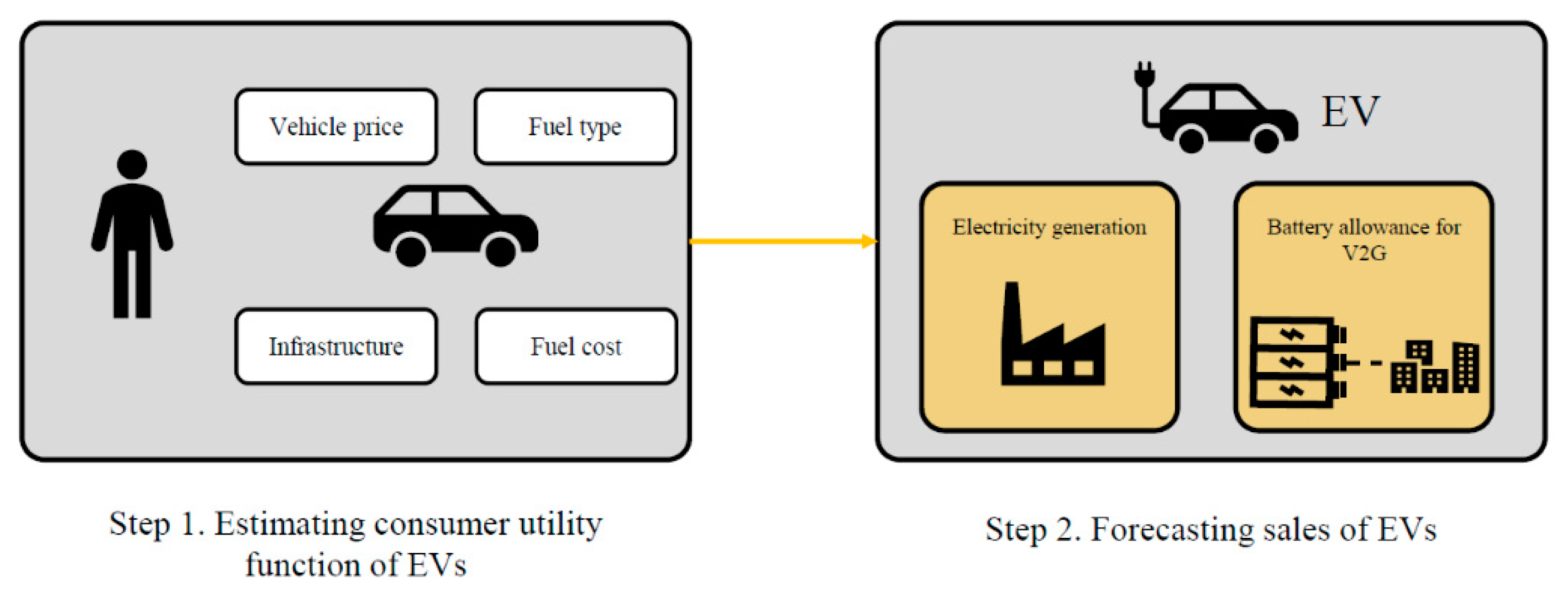

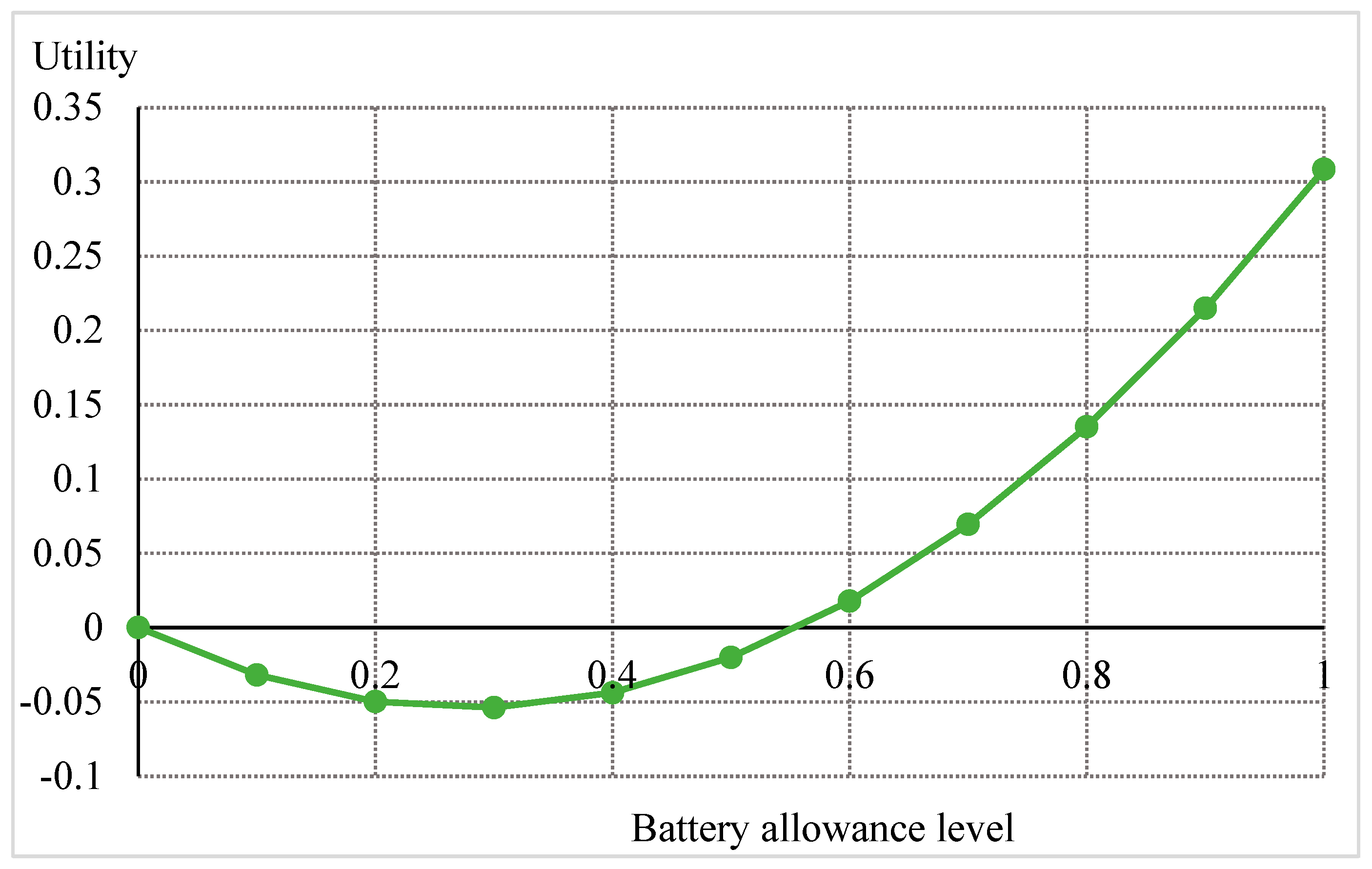
| Study | Region | Method | Key Findings |
|---|---|---|---|
| Hong et al. (2012) [17] | Korea | Mixed logit model | Consumers are willing to pay more to use the EV charging infrastructure. Social welfare change effected by possible government subsidy polices for EVs. |
| Egbue and Long (2012) [18] | United States | Chi-square test | Battery range is the biggest concern affecting uncertainty, followed by cost and the sustainability of fuel source. Subsidizing the cost of EVs and fuel taxes may have a negligible effect on the EV market. |
| Ziegler (2012) [19] | Germany | Multinomial probit model | Low acceptance is influenced by sparse battery charging stations, high battery costs, short driving distance, or a short battery service life. |
| Hoen and Koetse (2014) [20] | Denmark | Mixed logit model Multinomial logit model | Negative preferences for limited driving range, considerable range, refueling time, and fuel availability. Preference for AFVs increases with improvements in driving range, refueling time, and fuel availability. |
| Honarmand et al. (2014) [21] | Canda | Nonlinear programing | EV owners preferred to charge in the hour with lower electricity prices while discharge in the hours with higher electricity prices to sell the stored energy. Managing of the charging/discharging of EVs has eliminated the risk of an electricity demand growth during the peak load. |
| Koetse and Hoen (2014) [22] | Denmark | Mixed logit model Multinomial logit model | Conventional technology is preferred to AFVs because of limited driving range, long recharge/refueling time, and limited availability of refueling opportunities. |
| Parsons et al. (2014) [23] | United States | Random utility model | An increase in the willingness-to-pay (WTP) for EV can be achieved by providing consumers a contract that pays in advance, in the form of subsidy, in exchange for signing a V2G contract. |
| Sierzchula et al. (2014) [24] | 30 countries | Ordinary least squares | Incentives and EV adoption display a positive relationship. Charging stations and EV adoption rates display a positive significant relationship. |
| Ahn et al. (2015) [25] | - | Optimization simulation | Reflected the costs incurred by the electricity supply from each energy source to optimize the electricity generation mix for sustainability. |
| Gennaro et al. (2015) [26] | Florence, Italy | Scenario analysis with real driving database | The increase of electric energy demand from BEVs ranges from 0.7% to 18% of the total demand in the province. V2G interaction strategy can contribute to reducing from 5% to 50% the average daily electric energy demand in specific locations. |
| Hidrue and Parsons (2015) [27] | United States | Contingent valuation | Range anxiety, stringent V2G contract, high battery costs, and vehicle model play an important role in the WTP for V2G and EVs. |
| Huh et al. (2015) [28] | South Korea | Mixed logit model | Electricity mix is an important consideration in customer choice. Customers are willing to pay more to increase the renewable energy ratio. |
| Langbroek et al. (2016) [29] | Stockholm, Sweden | Mixed logit model | The probability of the stated EV adoption increases if policy incentives are offered. |
| Lim et al. (2016) [30] | South Korea | Multinomial logit model Nested logit model | Increase in available time for power sales has a positive effect on consumers’ marginal WTP. Decrease in residual power and increase in essential connection time have a negative impact on marginal WTP. |
| McLaren et al. (2016) [31] | United States | Scenario analysis | Carbon intensity of the electricity grid affects the total emissions associated with EVs. The greenhouse gas (GHG) emissions can be reduced when EV batteries are charged with electricity from renewables. |
| Suman et al. (2016) [32] | New York, United States | Linear Programming | With optimal solutions, the total charging cost is reduced by 18.5% and aggregator’s revenue is improved by 139% on average. The rise in number of EVs paralleled by an increase in aggregator’s revenue. |
| Freeman et al. (2017) [33] | New York, United States | A five-year economic model Sensitive analysis | Electricity sales through V2G system can create positive economic benefits for consumers even if their magnitudes are small. One-way power efficiency and battery lifetime are the key factors for consumers’ electricity transactions. |
| Gough et al. (2017) [34] | United Kingdom | A hybrid time-series/probabilistic simulation | Battery degradation cost and recharging in time have a significant impact on the feasibility of V2G services. The provision of energy to the wholesale electricity market produces an individual vehicle net present value of £8400. |
| Li et al. (2017) [35] | 14 countries | Multiple linear regression | The percentage of renewable energy in electricity generation, number of charging stations, user education level, and population density have apparent and positive impacts on the demands. |
| Woo et al. (2017) [36] | 70 countries | Well to wheel analysis | The ratio of resources to the electricity generation mix affects the GHG emissions of EVs. EVs were associated with higher GHG emissions than internal combustion engine vehicles in some countries. |
| Xiang et al. (2017) [37] | - | System dynamics simulation | Customer acceptance of EVs promotes adoption of EVs with the support of polices such as subsidies and the construction of charging infrastructures |
| Choi et al. (2018) [38] | South Korea | Mixed logit model | An environmentally friendly electricity generation mix promotes BEV adoption. The renewables-oriented mix scenario most effectively promotes BEV adoption. |
| Karmaker et al. (2018) [39] | Bangladesh | Hybrid Optimization of Multiple Energy Renewables (HOMER) | Solar and biogas based EV charging station reduces the burden on the national grid. The designed EV charging station saves approximately $12–$18 per month to recharge an EV which increases the socio-economic standard of EV owner. |
| Landi et al. (2018) [40] | United States | An optimization-based problem | Two controlled and uncontrolled charging schemes evaluate the aggregated charging profile of PEVs in parking lots. Reducing the total operating cost weakens the stability of the distribution system. |
| Moon et al. (2018) [41] | South Korea | Mixed logit model | Consumers prefer vehicles with lower fuel costs and vehicle prices, as well as diesel-type vehicles. Consumers prefer EVSEs with lower charging costs, shorter time to full charge, and greater accessibility. |
| Sachan and Adnan (2018) [42] | - | Optimization simulation with scenario analysis | The impact of different EV charging methods on distribution grid is assessed based on the reduction of network peak load demand and improvement in its operating condition. Wind power flow and electricity price variation are considered with stochastic availability of EVs. |
| Attribute | Levels | Details | |
|---|---|---|---|
| Fuel type | Gasoline, Diesel, Full hybrid, PHEV, BEV | A full hybrid vehicle mostly uses a gasoline engine and gasoline fuel for driving. However, it generates energy from the engine while driving to run the electric motor. It is possible to drive only by electric motor at the start and during low-speed driving. A PHEV has an external rechargeable battery, unlike the full hybrid. Hence, it can be driven using only the electric motor at any time. A BEV uses electricity as fuel and has little noise and a high initial acceleration. However, the travel distance of BEVs after full charge is shorter than that of ICEVs, and the electric charging time is longer than the fueling time of gasoline and diesel. | |
| (Only PHEV and BEV) | Electricity generation mix | Coal-, Nuclear-, LNG-, Renewable-oriented | Coal (coal 61%, nuclear 22%, liquefied natural gas (LNG) 13%, and renewables 4%) Nuclear (coal 38%, nuclear 43%, LNG 14%, and renewables 5%) LNG (coal 42%, nuclear 28%, LNG 24%, and renewables 6%) Renewable (coal 39%, nuclear 26%, LNG 15%, and renewables 20%) |
| Battery allowance for V2G (%) | 100, 70, 30, 0 | The battery allowance level is defined as the maximum proportion of allowable electric energy capacity at which you can lend electricity power from the charged battery of a vehicle. We assumed that the battery of the vehicle is charged up to 100%, and that electricity is mainly lent during the daytime and is recharged before the end of the working day. | |
| Accessibility of fueling/charging facilities (%) | 10, 50, 80, 100 | Taking the current supply level of a gasoline stations as reference, the accessibility of fueling/charging stations is defined as the ratio of the number of fueling/charging stations for a specific fuel type to the number of current gas stations. | |
| Fuel cost (KRW/km) | 50, 100, 150 | Fuel cost is defined as the cost of driving 1 km. | |
| Vehicle price (KRW 10,000) * | 2500, 3500, 4500, 5500 | The cost of buying a car is the purchase price. | |
| Characteristics | Number of Respondents (Ratio %) | |
|---|---|---|
| Total | 1000 (100%) | |
| Gender | Male | 507 (50.7%) |
| Female | 493 (49.3%) | |
| Age range (years) | 20–29 | 184 (18.4%) |
| 30–39 | 201 (20.1%) | |
| 40–49 | 233 (23.3%) | |
| 50–59 | 229 (22.9%) | |
| 60–69 | 153 (15.3%) | |
| Education level | Less than high school | 452 (45.2%) |
| University/college or higher | 548 (54.8%) | |
| Monthly household income | Under 3 KRW million | 165 (16.5%) |
| KRW 3–4 million | 190 (19.0%) | |
| KRW 4–5 million | 232 (23.2%) | |
| KRW 5–7 million | 277 (27.7%) | |
| Over KRW 7 million | 136 (13.6%) | |
| Vehicle usage pattern | ||
| Driver | Yes | 653 (65.3%) |
| No (Passenger) | 347 (34.7%) | |
| Purpose of driving | Commuting | 483 (74.0%) |
| Business | 56 (8.6%) | |
| Leisure/Travel | 15 (2.3%) | |
| Daily life | 99 (15.2%) | |
| Fuel cost per month | Under KRW 100 thousand | 37 (5.7%) |
| KRW 100–200 thousand | 183 (28.0%) | |
| KRW 200–400 thousand | 373 (57.1%) | |
| KRW 400–700 thousand | 58 (8.9%) | |
| Over KRW 700 thousand | 2 (0.3%) | |
| All Respondents (n = 954) | Driver Group (n = 618) | |||||||||
|---|---|---|---|---|---|---|---|---|---|---|
| Variables | ||||||||||
| Baseline | ||||||||||
| Gasoline (Reference) | ||||||||||
| Diesel | −0.6781 | *** | 0.9432 | *** | −0.0034 | 0.9823 | *** | |||
| Full hybrid | −0.2422 | ** | 0.9738 | *** | 0.3247 | * | 1.0031 | *** | ||
| PHEV | −0.1556 | 0.9984 | *** | 1.5725 | *** | 1.0179 | *** | |||
| BEV | −0.0214 | 0.9794 | *** | 2.1286 | *** | 1.0403 | *** | |||
| Plug-in hybrid or Electric | Electricity generation mix | coal-oriented (Reference) | ||||||||
| nuclear-oriented | −0.0093 | 0.9745 | *** | −0.8987 | *** | 1.0046 | *** | |||
| LNG-oriented | 0.1987 | * | 0.9962 | *** | 1.0334 | *** | 1.0319 | *** | ||
| Renewable-oriented | 0.0434 | 0.9777 | *** | 2.3921 | *** | 1.0164 | *** | |||
| Battery allowance for V2G | −0.001 | 0.9972 | *** | −0.3885 | ** | 1.0219 | *** | |||
| (Battery allowance for V2G)2 | 0.2144 | *** | 0.9764 | *** | 0.6969 | *** | 1.0108 | *** | ||
| Accessibility of fueling/charging stations | 1.7523 | *** | 0.8665 | *** | 5.5836 | *** | 0.9828 | *** | ||
| Fuel cost | −1.7892 | *** | 5.3306 | *** | −0.9123 | *** | 1.7842 | *** | ||
| Vehicle price | −0.7276 | *** | 0.4485 | *** | −0.4063 | *** | 0.2517 | *** | ||
| Satiation | ||||||||||
| Mean of | Mean of | Mean of | Mean of | |||||||
| Gasoline | −1.01963 | *** | 0.2651 | *** | −0.99107 | *** | 0.2707 | *** | ||
| Diesel | −1.02683 | *** | 0.2637 | *** | −1.48748 | *** | 0.1843 | *** | ||
| Full hybrid | −0.85732 | *** | 0.2979 | *** | −1.25058 | *** | 0.2226 | *** | ||
| PHEV | −0.85923 | *** | 0.2975 | *** | −2.47262 | *** | 0.0778 | *** | ||
| BEV | −0.75561 | *** | 0.3196 | *** | −2.55786 | *** | 0.0719 | *** | ||
| Accessibility of fueling/charging stations | −1.11199 | *** | 0.2475 | *** | −3.97683 | *** | 0.0184 | *** | ||
| Fuel cost | 0.308831 | *** | 0.5766 | *** | 0.076437 | *** | 0.5191 | *** | ||
| Alternatives | |||||||
|---|---|---|---|---|---|---|---|
| Fuel type | Gasoline | Diesel | Full hybrid | PHEV | BEV | ||
| Electricity generation mix | - | - | - | Scenario A | Scenario A-1 | Scenario B | |
| Coal (%) | 46.00% | 36.10% | 34.40% | ||||
| Nuclear (%) | 30.70% | 23.90% | 22.90% | ||||
| LNG (%) | 17.10% | 18.80% | 12.80% | ||||
| Renewable (%) | 6.30% | 20.00% | 30.00% | ||||
| Battery allowance (%) | - | - | - | 0/10/30/50% | |||
| Accessibility of fueling/charging stations (%) | 100% | 100% | 100% | 100% | 27.16% | ||
| Fuel cost (KRW/km) | 111.06 | 71.47 | 66.58 | 72.75 | 29.21 | ||
| Vehicle price (KRW 10,000) | 1431 | 1739 | 2373 | 2730 | 2807 | ||
© 2020 by the authors. Licensee MDPI, Basel, Switzerland. This article is an open access article distributed under the terms and conditions of the Creative Commons Attribution (CC BY) license (http://creativecommons.org/licenses/by/4.0/).
Share and Cite
Maeng, K.; Ko, S.; Shin, J.; Cho, Y. How Much Electricity Sharing Will Electric Vehicle Owners Allow from Their Battery? Incorporating Vehicle-to-Grid Technology and Electricity Generation Mix. Energies 2020, 13, 4248. https://doi.org/10.3390/en13164248
Maeng K, Ko S, Shin J, Cho Y. How Much Electricity Sharing Will Electric Vehicle Owners Allow from Their Battery? Incorporating Vehicle-to-Grid Technology and Electricity Generation Mix. Energies. 2020; 13(16):4248. https://doi.org/10.3390/en13164248
Chicago/Turabian StyleMaeng, Kyuho, Sungmin Ko, Jungwoo Shin, and Youngsang Cho. 2020. "How Much Electricity Sharing Will Electric Vehicle Owners Allow from Their Battery? Incorporating Vehicle-to-Grid Technology and Electricity Generation Mix" Energies 13, no. 16: 4248. https://doi.org/10.3390/en13164248
APA StyleMaeng, K., Ko, S., Shin, J., & Cho, Y. (2020). How Much Electricity Sharing Will Electric Vehicle Owners Allow from Their Battery? Incorporating Vehicle-to-Grid Technology and Electricity Generation Mix. Energies, 13(16), 4248. https://doi.org/10.3390/en13164248






